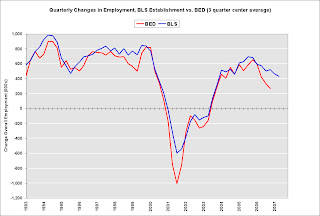by Calculated Risk on 8/23/2007 06:16:00 PM
Thursday, August 23, 2007
Residential Construction Employment Update
The BLS recently released the Business Employment Dynamics (BED) report for Q4 2006 (hat tip jg). The BED is another measure of employment and is based on state unemployment insurance.
According to the BED, overall construction employment (seasonally adjusted, Table B, page 3 of report), declined by 26,000 jobs in Q4 2006. This is close to the BLS estimate of 41,000 construction jobs lost for Q4.
In Q3 2006, the BED showed 77,000 construction jobs lost, compared to the BLS reporting 34,000 jobs gained (both seasonally adjusted). Click on graph for larger image.
Click on graph for larger image.
This chart compares the change in construction jobs as reported by the BLS establishment data and the BED. The BED is only available through Q4 2006.
Note this is all construction jobs, not just residential construction.
One of the possible answers to The Residential Construction Employment Puzzle is that the BLS missed the turning point in construction employment. Since housing completions fell off the cliff in Q1 2007, it will be interesting to see if the BED shows more construction jobs lost than the BLS in Q1 and Q2 2007.
Of course another explanation for the lack of job losses is that some construction employees have moved from residential to commercial work, but they are still being reported as residential construction employees to the BLS. (see here for more possible explanations). The BED will not shed light on that possible error, since the BED only reports total construction jobs. The second graph compares the quarterly change in employment estimate of the BLS establishment data vs. the BED starting in 1993 (three month centered average to smooth data).
The second graph compares the quarterly change in employment estimate of the BLS establishment data vs. the BED starting in 1993 (three month centered average to smooth data).
In the second half of 2006, the establishment data showed an increase of 1.137 million jobs (SA), and the BED showed only 0.535 million jobs (SA). This has led many analysts to expect the annual revision of the establishment data to show significantly fewer net jobs created over the last four quarters.


